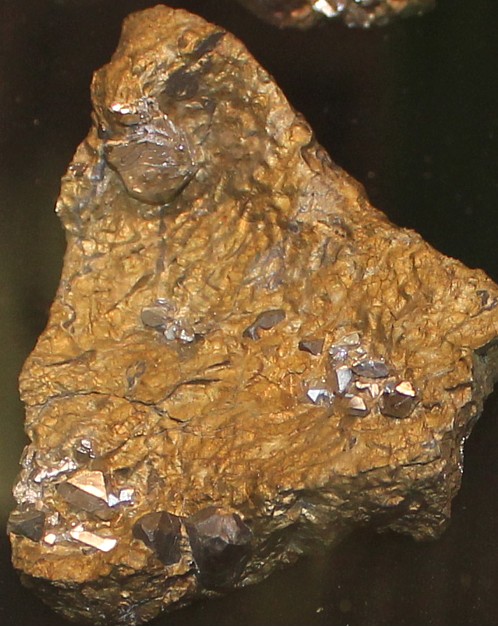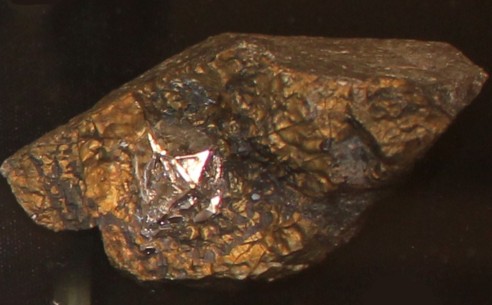|
.
Sperrylite Mineral Facts:
Chemical Formula: PtAs2
Arsenide of platinum
ideally containing 56.5 percent platinum. Actual specimens typically
contain small quantities of impurities including Rh, Cu, Sb, Pd and Fe.
The mineral belongs to the
pyrite family and therefore shares similar
crystal structure.
Colors:
Metallic tin white.
Has a black streak.
Hardness: 6.5
Density: 10.6
Cleavage:
Its cleavage is indistinct
parallel to (001).
Crystallography: Isometric
Usually in small grains, or in almost microscopic crystal fragments, but
larger crystals do occur. Their habit is usually a simple octahedral or
cubical and similar to the forms of pyrite.
Luster:.
Bright Metallic luster; opaque.
|

Above: Sperrylite (Silver colored
mineral) |
|
.
Composition,
Structure and Associated Minerals:
A very rare mineral, but is still by far the best known compound
containing platinum as an essential element which occurs in nature.
Sperrylite is generally
associated with layered mafic-ultramafic complexes in many of the locations
where it has been found. It is an important ore mineral of platinum. It is
mined with nickel ores and the platinum values of the sperrylite are
recovered in the ore processing and smelting operations.
The mineral was discovered in 1889 by Francis Louis Sperry, an
American chemist, in the nickel ores of Sudbury, Ontario. The mineral was
later named for him.
It does not readily oxidize or decompose as a part of normal weathering
processes and, consequently, has been reported as a trace mineral in widely
scattered alluvial deposits. Tiny crystals were found associated with
rhodolite
garnet and
corundum in 1898 during alluvial gem
mining in streams draining Mason Mountain, Macon County, North Carolina.
The placer flakes recovered from alluvial mining in North Carolina very closely resemble
native
platinum, from which they are of course, easily distinguished by a test for
the presence of arsenic.
|

Sperrylite from Norlisk, Russia |
|
|
Identification and Diagnostics
Before the blowpipe the mineral is fusible at 2. Roasted on charcoal
gives volatile white coating of arsenious oxide with characteristic
garlic odor. Roasted in the open tube, at first very gently, it gives
off arsenic fumes (which are highly dangerous) a platinum sponge is
left, which is insoluble in any single acid. Soluble in aqua regia.
Small pieces can appear similar to native platinum in some ways
(and both will give a test for platinum) but sperrylite has a lower
density and gives a positive test for the presence of arsenic.
Occurrence,
Localities and Origins:
Notable localities where sperrylite has been found include a
location with chalcopyrite in a
gold-quartz vein and as little crystals completely
embedded in the chalcopyrite (CuFeS2) and the gossan of a nickel mine, both near Sudbury, Canada.
It has been found with covellite at the
Rambler Mine, near Encampment, Wyoming.
Sperrylite has been identified in Finland from nickel
bearing sulfide deposits.
It is also recovered from the nickel mines of Norlisk in Russia. It
also occurs in the layered igneous complex of the Bushveld region of South
Africa.
Use: Sperrylite is an important ore mineral of platinum. In Canada, platinum
is obtained from the mattes obtained by smelting
the nickel
copper ore
of Sudbury, in Ontario. The high-grade mattes contain from O2 to 0-5 oz. of
platinum metals per ton. The platinum occurs in the Sudbury copper-nickel
ore as sperrylite, embedded in
chalcopyrite.
Platinum-bearing nickeliferous pyrrhotites are known to occur elsewhere, as
at the Norlisk deposits of Russia and in the Insizwa Range of South Africa.
Considerable amounts of platinum are still obtained from the Sudbury
mattes, and though the Insizwa deposits are smaller, they have also been
worked as a source of both platinum and nickel. At Sudbury, the platinum ore
is hosted by a nickeliferous pyrrhotite associated with chalcopyrite. It
occurs in a matrix of norite (hypersthene gabbro). This norite forms the
lower portion of a huge laccolitic intrusion, the upper portion of which
consists of a micropegmatite (a fine-grained mixture of quartz and
felspar). The Sudbury laccolite is a huge one. It covers an area of over 500
square miles, and its present volume is estimated to be not less than 600
cubic miles. The intrusion is probably of late pre-Cambrian age. The
laccolite is enclosed by pre-Cambrian rocks. It has a roof of altered
conglomerate. The floor of the laccolite consists of granite and
other igneous rocks, as well as various metamorphic rocks. The granite floor
is in part intrusive, and the ore-bodies doubtless owe some
of their peculiarities to readjustments effected as the result of these
later granite intrusions. It is supposed that the igneous magma became
differentiated after injection, forming a lower layer of norite containing
nickeliferous pyrrhotite and the other basic minerals which crystallized out
first and sank towards the floor of the laccolite.
Return to the
Mineral Collectors Information Page |
|


